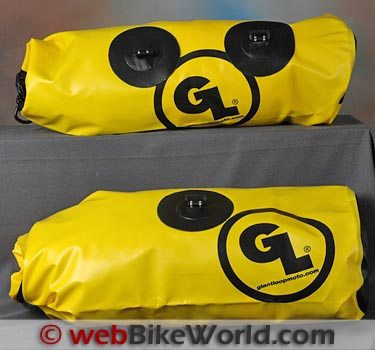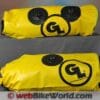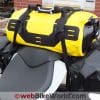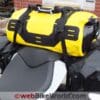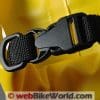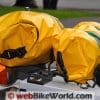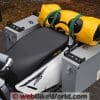The Giant Loop Coyote and Great Basin dry bags provide waterproof storage for clothes and gear.
The are designed to fit on the Giant Loop Coyote Saddlebag (review) or the Great Basin saddlebag.
While they do the job, both of these bags could use more tie-down points.
The interesting story of Giant Loop was described in detail in H.B.C.’s Giant Loop Coyote Saddlebag review in December of 2010.
The Giant Loop Coyote and Great Basin saddlebag systems have a unique shape and design.
They are what I would call highly focused dual-sport or off-road motorcycle luggage systems that work to yield the maximum amount of storage space in the minimum of size and weight.
The Giant Loop saddlebags will keep your gear waterproof too, which is nice to know after a wet day on the trail when you’re aching for a pair of dry socks and undies…
The Giant Loop Coyote and Great Basin dry bags that I’ve been using are designed to supplement the Giant Loop saddlebag systems.
I was asked to evaluate these products because I’ve used “dry bag” or “roll-top” waterproof luggage systems for many years during my boating and sailing adventures.
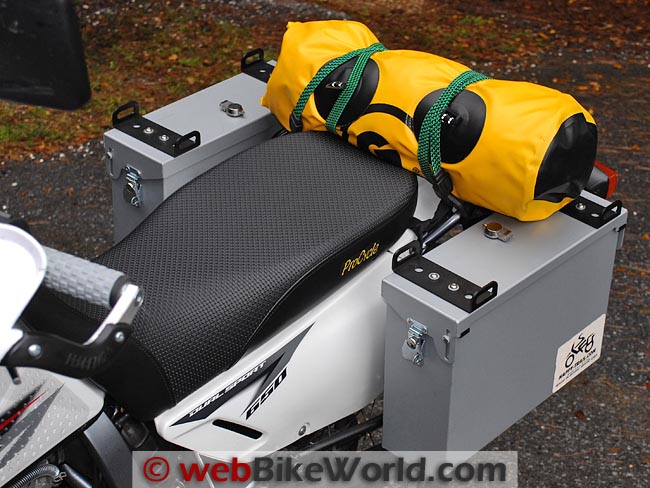
What Is a “Dry Bag”?
A “dry bag” (sometimes called a “roll top bag”) is, like its name suggests, a bag that will keep its contents dry.
It is usually made from a completely waterproof polyurethane and/or rubberized material and it can have one or more openings with specially designed types of closures that can be sealed to keep out water.
Dry bags are commonly used for water sports and for marine use. I’ve used basic dry bags in canoes, kayaks, powerboats, sailboats and just about every other type of water sport you can think of.
I’ve even paddled out in some pretty heavy lineups with camera equipment, food and gear for more than one all-day surf filming session!
I’ve learned that there are dry bags…and there are dry bags. Most any dry bag worthy of the name will keep its contents dry, but some are even designed to accommodate limited water immersion.
A water immersion dry bag usually has some type of special seal that usually consists of a clip that runs across the opening to seal the lip.
Then the opening is folded over a couple of times and secured, as is usually the case with any dry bag. The immersion type of dry bag is what I use when I’m in a canoe, kayak or on a paddleboard.
Dry bags come in many different shapes and sizes, including everything from cell phone dry bags up to very large duffels.
The most common shape is probably the basic round duffel bag or “stuff bag” that opens on one end, and this is the design used for the Giant Loop Coyote and Great Basin dry bags shown here.
This design could be described as a waterproof cylinder, open at one end only and with the special dry bag closure system used to secure the contents.
A very handy type of dry bag for motorcycle use is the square duffel bag type. There are also dry bag backpacks available.
The square dry bag type is usually easier to load because it has a waterproof zipper or closure across the top, so you don’t have to empty the entire bag to reach something at the bottom — a disadvantage of the duffel bag types that open at one end only.
Some dry bags even have a clear vinyl window along the side, so you can see what you packed. And some dry bags are made from a completely clear vinyl so you can see everything inside.
Also, many of the square types have multiple tie-down points and/or tie-down points at all four corners, which are very useful for securing the bag on a motorcycle. Some of the square types also have a removable shoulder strap and grab handles, again very useful.
The Giant Loop dry bags shown here are not the immersible types because they don’t include the special clip on the end to seal the bag opening.
However, they can be considered waterproof for motorcycle use because, if closed correctly, there is almost no chance that any water will seep in from even the heaviest rain or splashing you might experience on a bike.
Giant Loop states that the bags are “100% waterproof” but I would suggest only using that term for the immersible type of dry bag with the special sealing clip.
But again, for motorcycle use and in my biking experience using the bags over the last several weeks, the Giant Loop bags can be considered waterproof.
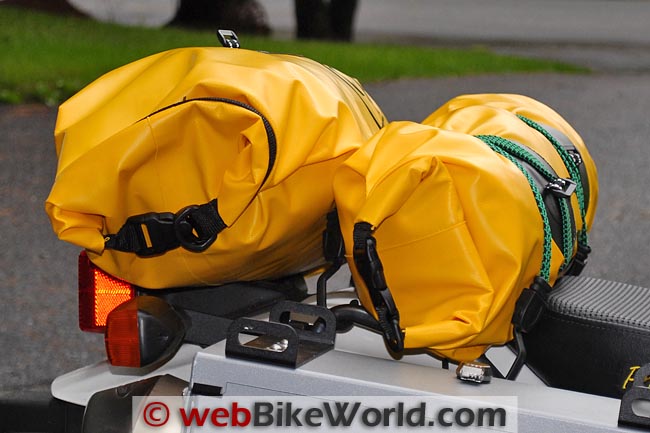
Giant Loop Coyote and Great Basin Dry Bags
The differences between the Coyote dry bag and the Great Basin dry bag are minor. Both bags are made in the U.S.A. from a type of heavy-duty polyurethane material we measured at about 0.5 mm thick.
Giant Loop says the material is 18 oz. for the body and 22 oz. on the (black) bottom, and we assume this is the weight per square yard.
All of the seams on the Giant Loop dry bags are completely sealed, either through a heat or radio frequency or some type of plastic welding process.
The Coyote dry bag is rated at 12 liters (730 cubic inches), while the Great Basin dry bag is 23 liters (1399 cubic inches). One thing I’ve always noticed about dry bags is they look bigger than the contents they can actually hold.
This is probably more true for the round duffel bag type that open at one end, like the Giant Loop bags.
After we took some static photos of the Coyote and Great Basin dry bags, I took them home to start the evaluation.
I initially thought the Great Basin would be too big for motorcycle use but, as you can see in the photo above, the difference isn’t really that noticeable, even though the Great Basin dry bag is just about twice the capacity of the Coyote dry bag.
In fact, I can say that I now prefer the Great Basin dry bag, because in actual use it really doesn’t seem much bigger than the Coyote bag and it’s easier to pack, due to its wider opening.
The Great Basin bag has a 25 cm (14″) wide opening, compared to a 28.5 cm (11.5″) opening on the Coyote bag.
That nearly 25% or so larger circle makes a big difference when you’re stuffing in clothes, a blanket or even a sleeping bag — sometimes difficult to do in a dry bag because the rubberized material can feel “sticky” and it tends to grab any fabrics on the contents as you’re trying to push them inside.
Also, the Coyote bag has two tie-down points on top, compared to only a single tie-down point on the Great Basin dry bag.
The tie-down points with small square D-rings are placed under large black circles of the heavier polyurethane, bonded or heat-welded to the outer surface of the bag.
There is a problem though — Giant Loop designed the attachment points to fit the thin, narrow webbed strapping on the Coyote or Great Basin saddlebags.
This is unfortunate, because a larger D-ring would allow other types of bungee cords or straps to be used to secure the bags. It’s difficult to do that with the current design because the D-ring openings are too narrow.
Also, if the bags had more tie-down points, such as D-rings on all four “corners”, the bags would work with or without attaching to the Giant Loop saddlebags.
I’m rather surprised that with the current design, Giant Loop seems to want to sell the dry bags to Giant Loop saddlebag owners only.
I would think there is a larger market share to be found if the bag design was such that it would be more useful on any motorcycle, with or without the Giant Loop saddlebags installed.
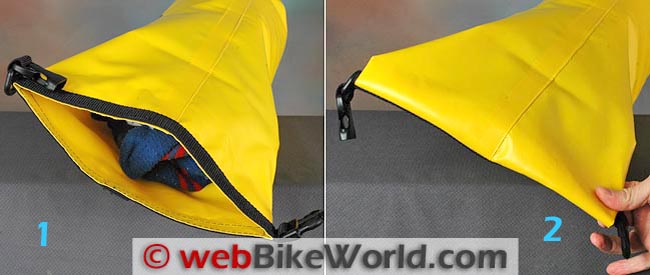

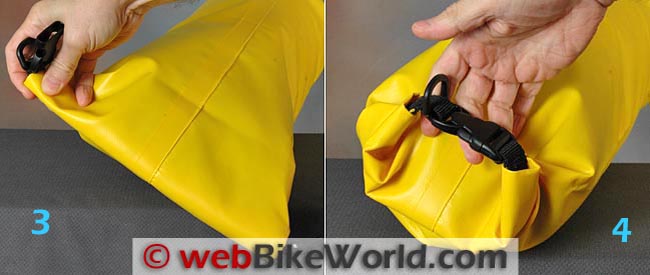


Closing a Dry Bag
Each of the Giant Loop dry bags have a very heavy-duty, 25 mm (1″) wide strip of nylon webbing seam-welded at the opening. The webbing has a nylon or plastic “Rock Lockster” brand side-release clip with a D-ring located on one side.
Securing a non-immersible dry bag is easy. First, fold the opening over once, then fold it over again. Then pull the clip around and close it.
That’s basically all there is to it. Note that the closed strap should always be located on the opposite side of the seal for optimal water resistance.
One thing I noticed on the Great Basin dry bags is that if you want to have the D-ring that is attached to the clip to be located on the outside of the strap but oriented so it’s on the same side of the bag as the square D-ring(s), you have to give the buckle end of the strap a half-twist before you snap it in.
Otherwise, the D-ring will be on the inside of the strap and the sealed opening will be pointing up when the bag is strapped down with the square D-rings on top.
This seems like a design error to me, because once you give the strap that half-twist, the opening doesn’t seal completely.
The way to test if a dry bag is sealed is to give it a “bear hug” squeeze. If you hear air hissing out of the seal, it probably isn’t closed correctly.
The Giant Loop dry bags will seal without air leaking if the bags are folded correctly, so my advice is to not give it the half-twist
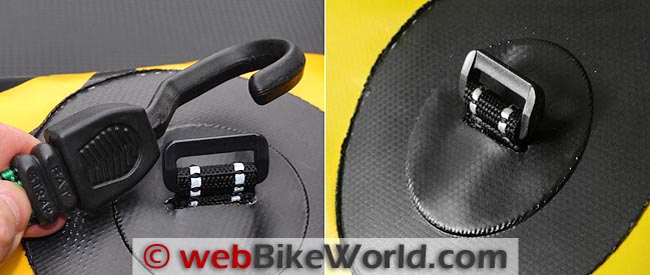


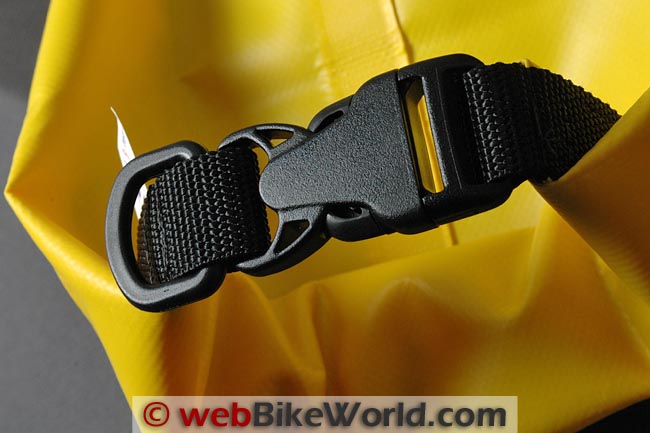


Conclusion
The Giant Loop Great Basin and Coyote dry bags are high-quality, heavy-duty bags that should keep your gear waterproof in any type of motorcycle riding condition I can think of.
A good dry bag isn’t cheap, but it takes time and effort to make one with completely sealed seams that will remain waterproof.
I think the Giant Loop dry bags would be more useful if they had more attachment points, although one of the benefits of the barrel-like design is the ease with which it can be tied down to various locations on the motorcycle.
The Great Basin dry bag is the logical choice here I think, because it only costs $4.00 more and it isn’t that much larger than the Coyote dry bag, but it’s easier to pack due to its larger “mouth” and it also has two tie down points.
| wBW Product Review: Giant Loop Coyote and Great Basin Dry Bags | |
|---|---|
| Manufacturer: Giant Loop | List Price (2011): $69.00-$73.00 |
| Colors: Black or White with Red, Black or Tan. | Made In: U.S.A. (Unconfirmed) |
| Colors: Yellow. | Sizes: Coyote: 12 liters. Great Basin: 23 liters. |
| Review Date: October 2011 | |
Note: Item provided by a retailer, distributor or manufacturer with these Terms and Conditions.
Note: For informational use only. All material and photographs are Copyright © webWorld International, LLC since 2000. All rights reserved. See the webBikeWorld® Site Info page. Product specifications, features and details may change or differ from our descriptions. Always check before purchasing. Read the Terms and Conditions!
Owner Comments and Feedback
See details on submitting comments.
From “M.R.” (January 2013): “I agree with your review. These are excellent bags, I’ve seen them take a lot of abuse including sliding down the road and laying against the muffler of a bike and still be usable.
The heat did markedly discolor the material and it will probably fail in the future but several years later they are still in use.
One other benefit is they seal out the dust which is no small thing when riding in a group out on sandy/dusty trails.”
From “R” (October 2011): “I disagree : Good dry bags are cheap. They are the cheapest form of waterproof luggage a motorcyclist can afford. Basically they are nautical or water sports equipment – big market and no rocket science design.
I have two yellow dry bags, 20 and 30 liters. Same design as the Giant Loop (at giant price!) and most of the other dry bags in the universe, except for the two attachment points on the side which you don’t need really. I strap one in a X pattern on my seat, simple.
I bought mine at Mountain Equipment Co-Op in Montréal in 2004 (I don’t work for them). The 20 liter today cost 20 $ and the 30 lliter, 24 $. They never failed me and the gods know how much rain can fall on Gaspésie! I can say I tested them.”


